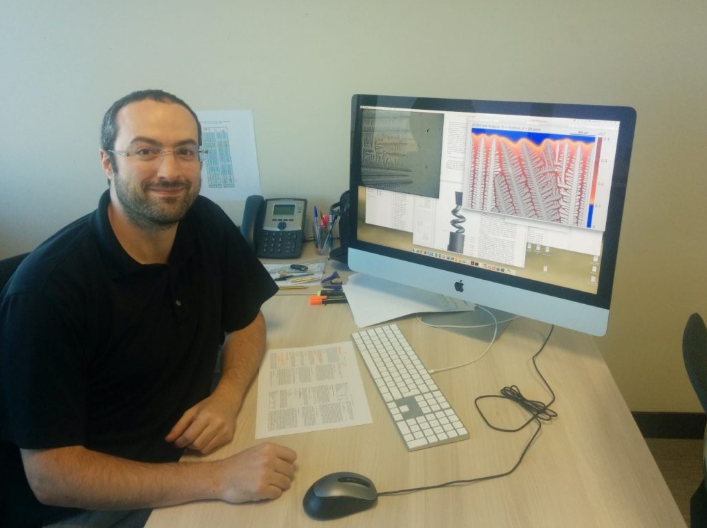«Dendritic microstructures are present in nearly every piece of metal around us»

Damien Tourret received an MSc in Mechanical Engineering from INSA Toulouse (France) in 2006 and a PhD in Materials Science & Engineering from École des Mines de Paris (Mines ParisTech, France) in 2009. Before joining IMDEA Materials, Damien was a Director’s Postdoctoral Fellow at Los Alamos National Laboratory (LANL, Los Alamos, NM, USA) from 2014 to 2017. He also held postdoctoral positions at the German Aerospace Center (DLR, Cologne, Germany) from 2010 to 2011 and at Northeastern University (Boston, MA, USA) from 2011 to 2014. His main research interests revolve around linking materials processing routes to microstructures and properties, with a particular emphasis on multi-scale modelling of solidification and phase transformations in metallurgical processing of metals and alloys. In 2017, he joined IMDEA Materials Institute to lead the research group on Modelling and Simulation of Materials Processing.
Starting this interview, would you explain us how your scientific vocation born? When and why did you take the decision to become a scientist?
As far as I can remember I’ve always been curious and wanted to find out how things work. As a kid, most toys under the Christmas tree would not last a day before being put apart because I needed to see what it was like inside – to my parents’ despair. I grew up in the southwest of France, in a small town just north of Toulouse. The city hosts the headquarters of Airbus, which plays a prominent role in the local economy and industry. Combined with a taste for science and some amount of chance, this lead me to study Mechanical Engineering. After graduating and a couple of internships, I realized what I really wanted to do was research. I like the idea of trying out new things and developing new methods, and I thought it would provide more space for creativity and exploration. So, I ended up in a PhD programme, and I enjoyed it enough to decide that’s what I wanted to do.
Can you tell us a little bit about your education and background? In which institutions have you been working for to date?
I graduated from INSA (National Institute for Applied Sciences) in Toulouse (France), spending a semester as an Erasmus student at Cardiff University in the UK, and then following up with a Master’s degree, also at INSA Toulouse. I earned a PhD in Materials Science and Engineering from the École des Mines de Paris (now Mines ParisTech), which is when I started working on solidification processing of metals and alloys. Then, I spent one year at the German Aerospace Center (DLR) in Cologne (Germany), running cool experiments on liquid metal droplets solidifying while electro-magnetically levitated. After that I spent three years and a half at Northeastern University in Boston, Massachusetts (USA), where I went back to do mostly modeling and simulations. I studied the effect of liquid convection on solidification microstructures, and took part in projects involving experiments performed aboard the International Space Station, in microgravity conditions aimed at reducing gravity-induced liquid buoyancy. Then, before joining IMDEA, I spent almost three years at Los Alamos National Laboratory in Los Alamos, New Mexico (USA). I joined a group strongly focused on real time X-ray imaging of metal alloys during liquid, or semi-solid, processing, while I continued developing multiscale simulation tools for solidification processing.
About IMDEA Materials. What was your motivation to join this institution?
One of the major goals behind my research is to enable predictions of mechanical properties, and ultimately performance of technological alloys, starting all the way from the liquid state processing stage. Most of what I have done so far focused on linking processing routes to the formation and evolution of microstructures, but rarely pushing it all the way to predicting properties resulting from these microstructures. Linking complex microstructures to equally complex mechanical properties is one of the main strengths at IMDEA Materials, so the synergy is really natural. I found a lot of research directions that were fitting almost perfectly with what I had been doing in the past, and most importantly with where I wanted to go in the future.
What research fields are you currently involved in? And, what specific results are you expecting to achieve?
Lately one of my most significant research direction has been investigating dendritic microstructure selection in the presence of liquid convection. Dendrites – tree-shaped structures similar to that of snowflakes – are ubiquitous in technological metals and alloys. During dendritic growth, solute and temperature gradients usually appear in the liquid phase, which under the influence of gravity lead to buoyant flow. While the phenomenon has been acknowledged for decades, we are far from a comprehensive quantitative picture of how gravity-induced buoyancy affects dendritic microstructure selection. This is primarily due to the wide spread of relevant length and time scales that need to be integrated together – from nanoscale solid-liquid interface capillarity to macroscale transport of mass and heat. Combining innovative multiscale approaches with modern massively parallelized hardware such as Graphics Processing Units (GPUs), we can now afford to run realistic simulations at relevant length and time scales, and perform “numerical experiments”. Extracting meaningful scaling laws for microstructural features, e.g. dendritic spacing or grain boundary density, under realistic gravity conditions would significantly improve our ability to quantitatively predict, and thus control, microstructures in technological metallic parts
What is the socio-economic usefulness that your research field has? How the society would obtain positive outcomes from your research?
Metallurgical activities – such as casting, welding, or additive manufacturing (i.e. 3D printing) of metals – accounts for nearly half of the total manufacturing value and over ten percent of the total gross domestic product (GDP) in the European Union (source: Metallurgy made in and for Europe, European Commission, 2014). Dendritic microstructures are present in nearly every piece of metal around us, and their mechanical properties depend directly on their inner microstructures. Therefore, beyond being a prime example of nonlinear pattern formation that has fascinated physicists for decades, dendritic growth has a fundamental importance for society. This is perhaps best exemplified by the transportation industry searching for ever stronger yet ever lighter materials, to improve personal safety and reduce its ecological footprint, all while minimizing production costs. Microstructures being the cornerstone between processing, properties, and performance, our ability to reliably predict them from a fully computational approach would tremendously accelerate the discovery and deployment of new materials and processes. Since the bronze age, advances in structural materials development has primarily relied on costly and tedious trial-and-error methods. By developing quantitative simulation tools, we are trying to move past that, and hopefully, progressively change the way future generations will approach metallurgical innovation.
As a young researcher, do you consider that you are in a creative and innovative period of your career?
Yes, I do. Over the past few years, as a postdoc, I started running into a number of scientific challenges and open questions for which I had clear pathways toward an answer, but just not enough time to follow them. I regularly came up with new ideas, and I even started a sort of “to-do list” of things to investigate when I would have time to. I guess this was a sign that I was ready to start a research group of my own.
Should companies bet on R&D and talented researchers? In order to enhance synergies between enterprises and academia, what would you propose?
I believe sustained interactions between private R&D and academic institutions are fundamental from both perspectives. In today’s economy both fundamental and applied research are moving extremely fast. From a company perspective, academic collaborations help them keep up with latest advances in understanding complex phenomena, and allow them to go to the bottom of things, deeper than they might afford on their own. Remaining at the cutting edge of theoretical research in their activities may save them millions and maybe lead to the next big technological breakthrough. From an academic perspective, making an effort to keep up with the fast-paced evolutions in new technological trends keeps you on your toes, and it ensures that your research remain relevant not only to you, but to a broader community. Because of that, I trust that all collaboration pathways are beneficial to all parties, whether it goes through frequent informal discussions, a student exchange programme, industrial doctorates, or the involvement of private companies in international academic research and training initiatives.
